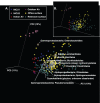Bacterial diversity in two Neonatal Intensive Care Units (NICUs)
- PMID: 23372757
- PMCID: PMC3553055
- DOI: 10.1371/journal.pone.0054703
Bacterial diversity in two Neonatal Intensive Care Units (NICUs)
Abstract
Infants in Neonatal Intensive Care Units (NICUs) are particularly susceptible to opportunistic infection. Infected infants have high mortality rates, and survivors often suffer life-long neurological disorders. The causes of many NICU infections go undiagnosed, and there is debate as to the importance of inanimate hospital environments (IHEs) in the spread of infections. We used culture-independent next-generation sequencing to survey bacterial diversity in two San Diego NICUs and to track the sources of microbes in these environments. Thirty IHE samples were collected from two Level-Three NICU facilities. We extracted DNA from these samples and amplified the bacterial small subunit (16S) ribosomal RNA gene sequence using 'universal' barcoded primers. The purified PCR products were pooled into a single reaction for pyrosequencing, and the data were analyzed using QIIME. On average, we detected 93+/-39 (mean +/- standard deviation) bacterial genera per sample in NICU IHEs. Many of the bacterial genera included known opportunistic pathogens, and many were skin-associated (e.g., Propionibacterium). In one NICU, we also detected fecal coliform bacteria (Enterobacteriales) in a high proportion of the surface samples. Comparison of these NICU-derived sequences to previously published high-throughput 16S rRNA amplicon studies of other indoor environments (offices, restrooms and healthcare facilities), as well as human- and soil-associated environments, found the majority of the NICU samples to be similar to typical building surface and air samples, with the notable exception of the IHEs which were dominated by Enterobacteriaceae. Our findings provide evidence that NICU IHEs harbor a high diversity of human-associated bacteria and demonstrate the potential utility of molecular methods for identifying and tracking bacterial diversity in NICUs.
Conflict of interest statement
Figures


Similar articles
-
Intra-hospital microbiome variability is driven by accessibility and clinical activities.Microbiol Spectr. 2024 Aug 6;12(8):e0029624. doi: 10.1128/spectrum.00296-24. Epub 2024 Jun 28. Microbiol Spectr. 2024. PMID: 38940596 Free PMC article.
-
High-Resolution Differentiation of Enteric Bacteria in Premature Infant Fecal Microbiomes Using a Novel rRNA Amplicon.mBio. 2021 Feb 16;12(1):e03656-20. doi: 10.1128/mBio.03656-20. mBio. 2021. PMID: 33593974 Free PMC article.
-
The developing premature infant gut microbiome is a major factor shaping the microbiome of neonatal intensive care unit rooms.Microbiome. 2018 Jun 20;6(1):112. doi: 10.1186/s40168-018-0493-5. Microbiome. 2018. PMID: 29925423 Free PMC article.
-
Then and now: use of 16S rDNA gene sequencing for bacterial identification and discovery of novel bacteria in clinical microbiology laboratories.Clin Microbiol Infect. 2008 Oct;14(10):908-34. doi: 10.1111/j.1469-0691.2008.02070.x. Clin Microbiol Infect. 2008. PMID: 18828852 Review.
-
Antibiotic Resistance and Biofilm Infections in the NICUs and Methods to Combat It.Antibiotics (Basel). 2023 Feb 8;12(2):352. doi: 10.3390/antibiotics12020352. Antibiotics (Basel). 2023. PMID: 36830264 Free PMC article. Review.
Cited by
-
Monitoring Seasonal Changes in Winery-Resident Microbiota.PLoS One. 2013 Jun 19;8(6):e66437. doi: 10.1371/journal.pone.0066437. Print 2013. PLoS One. 2013. PMID: 23840468 Free PMC article.
-
Characterization of SARS-CoV-2 Distribution and Microbial Succession in a Clinical Microbiology Testing Facility during the SARS-CoV-2 Pandemic.Microbiol Spectr. 2023 Mar 14;11(2):e0450922. doi: 10.1128/spectrum.04509-22. Online ahead of print. Microbiol Spectr. 2023. PMID: 36916973 Free PMC article.
-
Bioinformatic and Statistical Analysis of Microbiome Data.Methods Mol Biol. 2023;2629:183-229. doi: 10.1007/978-1-0716-2986-4_10. Methods Mol Biol. 2023. PMID: 36929079
-
Genetic relatedness in carbapenem-resistant isolates from clinical specimens in Ghana using ERIC-PCR technique.PLoS One. 2019 Sep 12;14(9):e0222168. doi: 10.1371/journal.pone.0222168. eCollection 2019. PLoS One. 2019. PMID: 31513633 Free PMC article.
-
Exploring the Hospital Microbiome by High-Resolution 16S rRNA Profiling.Int J Mol Sci. 2019 Jun 25;20(12):3099. doi: 10.3390/ijms20123099. Int J Mol Sci. 2019. PMID: 31242612 Free PMC article.
References
-
- Couto RC, Carvalho EA, Pedrosa TM, Pedroso ER, Neto MC, et al. (2007) A 10-year prospective surveillance of nosocomial infections in neonatal intensive care units. Am J Infect Control 35: 183–189. - PubMed
-
- Stover BH, Shulman ST, Bratcher DF, Brady MT, Levine GL, et al. (2001) Nosocomial infection rates in US children's hospitals' neonatal and pediatric intensive care units. Am J Infect Control 29: 152–157. - PubMed
-
- Urrea M, Iriondo M, Thio M, Krauel X, Serra M, et al. (2003) A prospective incidence study of nosocomial infections in a neonatal care unit. Am J Infect Control 31: 505–507. - PubMed
-
- Stoll BJ, Hansen NI, Adams-Chapman I, Fanaroff AA, Hintz SR, et al. (2004) Neurodevelopmental and growth impairment among extremely low-birth-weight infants with neonatal infection. Jama 292: 2357–2365. - PubMed
Publication types
MeSH terms
Substances
Grants and funding
LinkOut - more resources
Full Text Sources
Other Literature Sources
Medical
Molecular Biology Databases

